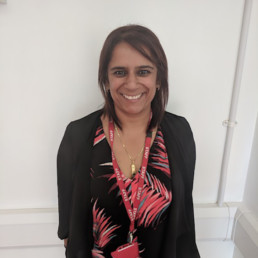Cultural Competency

Written by Amardeep Panesar
Headteacher with two decades of experience in education
As an ethnic minority leader, many challenges and barriers do come our way. It is how you perceive them and more importantly yourself in order to be successful. I personally, do not see these as hindering barriers, but challenges that I know I/ we can overcome, depending on “how badly I want something”. A philosophy that most definitely comes from my foundation and sports participation – let your work do the talking!
I’m writing my first blog on Cultural Competency based on a fantastic opportunity given to me by Diverse Educators in particular Hannah Wilson, following the response on social media, I’ve realised just how powerful this platform really is in developing educators! So let’s do it…
Why is it important to be culturally aware of the needs of our children?
Let us first look at the statistics:
- African / African Caribbean people face more ingrained pathways into the criminal justice system as a result of greater levels of disengagement and exclusion from school (Wright, Francis and McAteer, 2015).
- Over the last five years, the number of young ethnic minority people in the UK who are long term unemployed has almost doubled, whereas for young white people it fell slightly.
- In 2014, the probability of Black African women being detained under mental health legislation in England was more than 7 times higher than for White British women.
- People from ethnic minorities are twice as likely to live in poverty compared to White people across Britain.
With these statistics against us and the young people we work with, it is crucial to be culturally competent when educating our young children. Both for adults who are from and ethnic minorities and those that are not, in order to give our children the best possible life chances in order to become successful citizens.
In order to fully support and understand, it is critical to understand self and others perceptions, which can be categorised under four main areas:
- Attitudes and beliefs towards others.
- Attitudes and beliefs towards others of the same group.
- Attitudes and beliefs towards members of different minorities and
- Attitudes and beliefs towards members of the dominant group.
As we read on, do take a moment to self reflect and and understand your own perceptions towards others, because we all have them. We are naturally hard wired to like people like ourselves, people who look like us, think like us, share similar values and visions. We need to continue to educate our staff and children on how/ why these perceptions exist and how collectively, over time, things will start to change by listening to each other. Diverse education is crucial, in all areas, especially in culturally diverse schools.
We can all share our experiences through school leadership and educating children. For me, as an ethnic minority leader, everything I have learnt so far has only empowered me to support others in our profession and to help individuals understand culture and children! Every day we learn…
The world assumes the young people of colour will fail or behave a certain way, we as educators, MUST do the opposite.
Diversifying representation while working with textbooks

Written by Chris Richards
MEd in Applied Linguistics and currently works as a Teacher Mentor in Madrid
I have a vivid memory of being told about the importance of images in my classroom. It was 2010, I was doing my PGCE and was eager to start teaching. I remember that this was the first moment of many that shaped the way I have approached diversity and inclusivity in the classroom ever since. As this post explains, the issue of representation in the classroom has come back to me again in recent years.
When I was teaching English language and literature in England and Wales, we made very little use of textbooks. This certainly made things challenging for a newbie, but to focus on the positive, it also gave me a lot of freedom to make my own choices about which images in the classroom. I learned quickly that you have to be careful when you do internet image searches and not for the reasons we tell our young pupils to be careful. Just last week, in preparation for my contribution to DiverseEd: The Virtual Conversation, I searched for some images. With the search term ‘reading’ I found mostly kids, mostly white. The first four were of girls and the first negative image I found was a bored boy holding a book. When I searched for ‘man reading’, men from BAME backgrounds appeared just twice in the first thirty-two images, and the first appeared twelfth.
In 2016, I moved to Spain and began teaching English in a private language academy. It was a huge change in pace, lifestyle and teaching philosophy, and was the new challenge I needed. Aside from very small class sizes (I now work with a maximum of eight), the biggest difference was the use of a course book. In the first institution I worked in here, every group has an assigned course book that we followed across the course of the academic year. Very quickly, I started to notice that representation was very narrow and, while studying for my MEd in Applied Linguistics, I decided to write my dissertation on how gender and sexuality get represented in a sample of course books. It all began with a page about “different” weddings in the UK that had four photos: four straight, white couples. To paraphrase 20,000 words, on the whole, gender was presented rather traditionally, although there were some images of women in positions of power; minority sexuality was conspicuously absent from the pages.
Whether we’re working with course books or not, we should always be ready to substitute and supplement, especially so with images as these can be a very powerful way to give, or withhold, representation. We also need to consider what texts pupils are reading, lest they are always reading the same stories and hearing the same voices. Whose stories do get told and who gets effectively silenced in our classrooms? If we give space to one image or story, we reduce the space for others. Ultimately, this is simply a question of inclusion.
Also crucial is asking ourselves what unwanted or unintended associations inclusion might bring. For example, are people with disabilities routinely referred to in heroic situations, overcoming their disability rather than as people whose identities extend beyond their differences? Are we remembering to show women in positions of power and responsibility outside the home, but forgetting to represent men in caring or homemaking roles? Are LGBTQ+ folk only shown when their minority sexuality is the defining factor?
Asking ourselves these questions initially is effort, but once it becomes habit, once it becomes part of planning and preparation routine, it becomes normal. I can’t look at a course book page now without quickly scanning it for representation. I don’t always choose to substitute and at other times I might specifically leave unrepresentative material as it is, and ask my students what they think might be missing. I turn over that critical evaluation process to them, so they can start to perform this analysis themselves. After all, I won’t always be there to recast the material they encounter in their reading and viewing lives.
My final thought is that we should always be asking ourselves who gets a voice and who gets seen in our classrooms.
Chris Richards, Teacher Mentor
Chris first taught in the UK high school system in inner city Birmingham and South East Wales, but has been working in English Language Teaching (ELT) since 2015. He holds an MEd in Applied Linguistics and currently works as a Teacher Mentor in Madrid. He is particularly interested in inclusivity/diversity, literature, and the use of first language in the ELT classroom.
Menopausal Musings: What to expect as a Senior Leader with the menopause

Written by Nicky Bright
Leadership development consultant with over 30 years of experience
A post written in response to the TES article ‘what to expect as a Senior Leader with pregnancy’.
I originally wrote this article last Easter and tore it up as being ‘too close to home’. A taboo subject, and one that has only really been raised more widely over the last 18 months or so, I worried how it would be received, and I would be perceived. But Emma Seith’s TES article on 19th July 2019 emboldened me to have another go. I had only recently sought help for the symptoms I had been experiencing with increasing intensity for about 18 months, without really realising that a) they were symptoms and b) help was available. Instead, I thought I was simply not coping well with increased pressures of work, but not wanting any signs of weakness or vulnerability to show. How wrong I was.
Menopausal women are the fastest growing demographic in the workplace (ONS 2018) and with a retention and recruitment crisis, and our profession being dominated by women, albeit with proportionately more men in senior roles, we should take note, whether we are personally affected by the menopause or increasingly surrounded by those who are. For every ten women experiencing menopausal symptoms, six say it has a negative impact on their work (CIPD 2019). We cannot afford to lose highly skilled and experienced staff who simply need some support, and perhaps don’t realise it themselves.
I now realise that I was not alone in feeling like this, as the menopause was relegated to a cursory mention when I was at school. Our biological education really only emphasised understanding your cycles sufficiently to avoid pregnancy. The portrayal of menopausal women until recently has been derogatory and laughable, providing Les Dawson and others with endless comic material. Women of a certain age are ‘washed-up’, ‘over the hill’, ‘a little neurotic’ and so on. Kirsty Wark’s 2017 BBC programme on Menopause raised the tone of the debate and is one of the pieces of journalism of which she is most proud, understandably in my opinion. Now everyone is starting to talk about it, and even more so with the announcement of a procedure to delay it for 20 years or longer (https://www.bbc.co.uk/news/topics/cxwkx729dx2t/menopause). As Liz Earle said in Stella Magazine (21 April 2019), ‘If you ask any Head of HR ‘What’s your maternity or paternity policy?’, they’ll produce a document. If you say ‘What’s your menopause policy?’ there’s silence.’
As a senior leader, I’m not advocating yet another policy for us to have to update annually, but there does need to be some discussion to ensure that this vital and growing part of our workforce are not unfairly disadvantaged because of ignorance, and simply leave. We all know women who have taken earlier retirement than they may have originally envisaged who have simply ‘had enough’ and are exhausted and don’t even think to ask for help, because they probably don’t realise that, in many cases, they can be helped. Some women sail through without any difficulties, but if increasing numbers of women are working longer, and also reaching leadership positions, we need to help those who aren’t sailing through, so we can all benefit from their years of experience and talent.
Sleep deprivation is known as a tool of torture, and many young parents suffer from it. However, it is less commonly known that fatigue, through disrupted sleep patterns, heightened anxiety and hot flushes, is very common to menopausal women too. With the right support in place we can make the most of their experience and talents in the same way we do for young parents. What about rearranging a member of staff’s timetable for a year or two, so they can come in later if they have been awake half the night, or letting them go slightly earlier if their exhaustion kicks in at the end of the day. Not always possible or indeed necessary, but everyone is different and without a conversation who would know what might help? Giving staff more individual control over ventilation in classrooms can be difficult in very old buildings or new ‘climate controlled’ green buildings, so providing a fan is a simple way to help. Ensuring staff teach in classrooms close to toilet facilities is another relief for those who suffer from ‘flooding’ or need to go more regularly. Much is made of mental health support for staff these days, quite rightly, and the increased levels of anxiety and depression some women suffer can be supported too. CIPD and the NEU produce great guides for HR teams, people managers and materials to get people talking about their experiences so they can be helped, and direct others towards the right help for them.
With the benefit of HRT, more exercise because I have more energy again, talking therapies support and lots of reading and discussion with empathetic others about this, I am now feeling much more myself again – my new older self. On my journey, I have come across lots of work being done in other industries and professions to support this fastest growing working demographic, and so on Monday 18th November at the GSA Head’s Conference in Bristol I will be running a seminar with Inspector Julie Knight of Avon and Somerset Police to discuss how we can better support our staff (and ourselves?) in education. The Constabulary have had overwhelmingly positive feedback about the menopause awareness days they run, and the support networks they facilitate – we can learn from this. Women make up nearly half of their workforce with 34% over the age of 46. They have an open and proactive approach to supporting individuals and managers in order to support and retain talented staff.
I’m pleased to hope that younger women won’t ‘not realise’ what is happening to them for as long as I did, because this taboo is now being properly discussed, and so they will be prepared mentally and physically to ask for and accept help if necessary. I’m also hopeful that we can help to stem the loss of valuable talent to our profession, because our staff will feel respected and supported. And who knows, perhaps younger women won’t even need to go through it at all…

